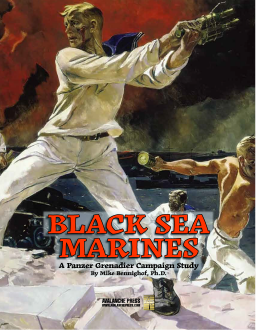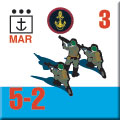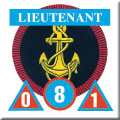| Black Sea Marines
Scenario Preview, Part One
By Mike Bennighof, Ph.D.
June 2023
 I designed the Panzer Grenadier game system around the interactions of tanks and infantry (hence the name); each of these having equal importance. So it was a design goal from the start that infantry would have interesting things to do, and scenarios that only had infantry on both sides would still be fun to play. I designed the Panzer Grenadier game system around the interactions of tanks and infantry (hence the name); each of these having equal importance. So it was a design goal from the start that infantry would have interesting things to do, and scenarios that only had infantry on both sides would still be fun to play.
That reads fairly nonsensically on the screen, but most wargames set at this level didn’t see things that way before Panzer Grenadier came along. The ancient Panzerblitz, the great-grandfather of all tactical wargames, was a tank game with infantry allowed to serve as targets, and sometimes to hold onto the town where they started the game (they didn’t move fast enough to do anything else).
While Panzer Grenadier models infantry combat pretty well (considering that it’s a game, and one intended to be played by humans), I think it’s at its best when at least one side deploys elite infantry. The Black Sea Fleet Marines are definitely that; the Romanians they fight are adequate foes (they would never regain the generation of young officers and the overall confidence they lost in front of Odessa), and the Germans are at this stage of the conflict are still very good at war. In both cases, the Marines are usually outnumbered, sometimes pretty badly.
The Black Sea Fleet’s Marines are the headliners of Panzer Grenadier: Black Sea Marines, a Campaign Study with 10 new scenarios focused on the battles of the Black Sea Fleet’s Marines against the Axis invaders. You’ll also needs maps and pieces from River Battleships and Fire in the Steppe, and pieces from Armata Romana.
Let’s have a look at the first chapter, drawn from the Siege of Odessa.
Chapter One
Defense of Odessa
Odessa had an important part in the revolutionary mythology of the Red Navy, thanks to the 1905 mutiny aboard the battleship Potemkin, cemented by the 1925 Sergei Eisenstein film. The city itself hosted a massive commercial port but relatively limited shipbuilding and military installations, but due to its importance for grain exports it also had a fair number of Marines stationed there.
When war came in June 1941, those men were formed into the 1st and 2nd Marine Regiments; a 3rd Marine Regiment would be formed in Sevastopol and join the garrison in September. All three regiments saw extensive action defending Odessa as part of the 421st Rifle Division, and their surviving Marines would fight again in Crimea.
Scenario One
Defense of Vyhoda
20 August 1941
 The 1st Marine Regiment, formed from the Marine units in the Odessa Naval Base, was inserted into the front lines on the north-west sector of the Odessa Fortress, between the 25th and 95th Rifle Divisions. The Marines fought off the first Romanian assaults on their positions on the 18th; the main Romanian effort came to the east against 95th Rifle Division. But on the morning of the 20th, the Romanian III Corps aimed their remaining armor and their artillery support against the men in black. The 1st Marine Regiment, formed from the Marine units in the Odessa Naval Base, was inserted into the front lines on the north-west sector of the Odessa Fortress, between the 25th and 95th Rifle Divisions. The Marines fought off the first Romanian assaults on their positions on the 18th; the main Romanian effort came to the east against 95th Rifle Division. But on the morning of the 20th, the Romanian III Corps aimed their remaining armor and their artillery support against the men in black.
Conclusion
The Marines repelled the tank-backed Romanian assault with the help of the attached machine-gunners of the Tiraspol Fortified Region and their own 76.2mm field guns. The Romanians kept advancing despite their horrendous losses, and the Marines kept holding their ground. Eventually the Romanian corps broke off their assault on Vyhoda, but would resume the attack a few days later.
Notes
The Romanians bring tanks (not very good ones) to the battlefield and have artillery support (much better than their tanks), but no help from the Air Force. This one is going to be a brutal, close-quarters infantry fight. The Romanians are not up to Marine standards, but are by no means the broken army of the war’s later years (it was Odessa that broke them).
Scenario Two
Defense of Chebanka
24 August 1941
 On the eastern flank of the Odessa perimeter, the Romanian V Corps opened a major assault with two infantry divisions, a cavalry brigade, and the remnants of their lone armored division, with the Germans providing artillery support for the first time. The Soviet defenders in this sector – three mixed regiments not yet collected into a division- faced overwhelming pressure, but with Odessa surrounded they had no option to retreat. On the eastern flank of the Odessa perimeter, the Romanian V Corps opened a major assault with two infantry divisions, a cavalry brigade, and the remnants of their lone armored division, with the Germans providing artillery support for the first time. The Soviet defenders in this sector – three mixed regiments not yet collected into a division- faced overwhelming pressure, but with Odessa surrounded they had no option to retreat.
Conclusion
The much-vaunted German artillery proved surprisingly ineffective, and the Romanian cavalry had to engage the Soviet Marines in close-quarters fighting to make any headway. Eventually they did so at the cost of brutal casualties, and the Marines gave up the seaside town of Chebanka and its coastal defense positions.
Notes
This time the Marines have to hold on against enemy cavalry, who have heavy artillery behind them (that’s not usually the case with the lightly-supported horsemen). The Romanian cavalry have very high morale and good leadership, but aren’t well-supplied with heavy weapons.
Scenario Three
Stand at Fontanka
28 August 1941
 The Romanian V Corps continued its drive, with the coastal town of Fontanka at the north-eastern edge of Odessa’s harbor a prime target. From here, Romanian artillery could engage ships within the harbor with direct fire, and likely make it impossible for the Soviet Black Sea Fleet to continue bringing in reinforcements and supplies. If the Romanians could take the town, the Soviet defense of Odessa would likely unravel. The Romanian V Corps continued its drive, with the coastal town of Fontanka at the north-eastern edge of Odessa’s harbor a prime target. From here, Romanian artillery could engage ships within the harbor with direct fire, and likely make it impossible for the Soviet Black Sea Fleet to continue bringing in reinforcements and supplies. If the Romanians could take the town, the Soviet defense of Odessa would likely unravel.
Conclusion
The Marines hung on against repeated infantry assaults backed by heavy artillery bombardment, but had the support of Fontanka’s 203mm coastal defense battery. The Romanian failure to capture Fontanka and its battery would extend the siege of Odessa by another month.
Notes
The Marines are dug in and must hold out; casualties mean nothing to them, only the ability to stand their ground. The Romanians have little choice but to dig them out of their positions one by one.
Scenario Four
Landing at Grigoryikva
22 September 1941
 The first Soviet amphibious landing of the Great Patriotic War would take place behind the left or eastern flank of the Romanian Fourth Army. Most action had been taking place on the western side of the perimeter, and the Soviet command hoped that the Romanian divisions in this relatively quiet sector had become complacent over the previous weeks. A parachute detachment would conduct an airborne landing to help disrupt the Romanian rear areas. The first Soviet amphibious landing of the Great Patriotic War would take place behind the left or eastern flank of the Romanian Fourth Army. Most action had been taking place on the western side of the perimeter, and the Soviet command hoped that the Romanian divisions in this relatively quiet sector had become complacent over the previous weeks. A parachute detachment would conduct an airborne landing to help disrupt the Romanian rear areas.
Conclusion
The Marines stormed ashore and took the Romanians by surprise. With the aid of strong gunfire support from cruisers and destroyers hovering just offshore, the Marines quickly established a beachhead and took control of the coastal road. The Romanians had little choice but to pull back from their hard-won gains in front of Fontanka.
Notes
It’s an amphibious landing, one of the few (perhaps the first) in the Eastern Front games of Panzer Grenadier. The Soviets don’t really have a naval bombardment doctrine yet so the offshore gunnery is kind of haphazard, but we couldn’t have a book like this without Marines doing what Marines do.
Scenario Five
East of Fontanka
22 September 1941
 While the 3rd Marine Regiment landed at Grigoryivka, the 1st and 2nd Marine Regiments, now part of the 421st Rifle Division, took part in the accompanying ground assault. The garrison’s few tanks and an armored train joined the attack, designed to push the Romanian artillery batteries out of range of Odessa’s harbor. While the 3rd Marine Regiment landed at Grigoryivka, the 1st and 2nd Marine Regiments, now part of the 421st Rifle Division, took part in the accompanying ground assault. The garrison’s few tanks and an armored train joined the attack, designed to push the Romanian artillery batteries out of range of Odessa’s harbor.
Conclusion
The Soviet offensive quickly saw enormous success, pushing the Romanian lines back up to ten kilometers and overrunning artillery positions (though the Romanians evacuated the guns in time) and supply depots. The success freed Odessa’s harbor from Romanian artillery fire, prompting the garrison’s command to make plans to hold through the coming winter; the Soviet high command saw it instead as an opportunity to extract the garrison and concentrate its forces for the defense of Crimea, where the Germans had just broken into the peninsula. The evacuation began 10 days later.
Notes
Now this is a fun one, at least for the Soviet player. The Marines get tank support (not a lot of it, but some) and we finally get to use that armored train from Fire in the Steppe (which does not appear in any of that game’s scenarios). And given the battle’s importance to the looming evacuation of the Independent Coastal Army (the Odessa garrison) to Crimea, it makes a good segue to our second chapter.
And that’s all for Chapter One. Next time, we move to Crimea for Chapter Two.
You can order Black Sea Marines right here.
River Marines
River Battleships
Black Sea Marines
Retail Price: $62.98
Package Price: $50
Gold Club Price: $40
You can order the River Marines right here.
Sign up for our newsletter right here. Your info will never be sold or transferred; we'll just use it to update you on new games and new offers.
Mike Bennighof is president of Avalanche Press and holds a doctorate in history from Emory University. A Fulbright Scholar and NASA Journalist in Space finalist, he has published a great many books, games and articles on historical subjects; people are saying that some of them are actually good.
He lives in Birmingham, Alabama with his wife, three children, and new puppy. He misses his lizard-hunting Iron Dog, Leopold.
Want to keep Daily Content free of third-party ads? You can send us some love (and cash) through this link right here.
|
